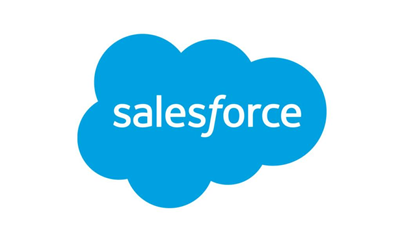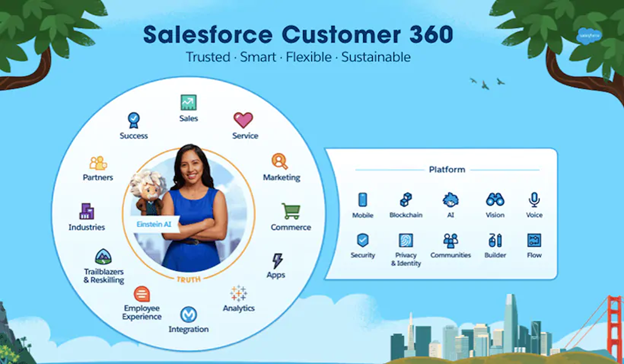May the FORCE be with you! What is this company’s secret to bringing businesses and customers together? [Monday Marketing Marvels]

Imagine this scenario: You ordered an item from a brand’s online site and when it was delivered to your house, you found out that the item was defective.
You emailed the brand regarding the issue and after a week, there’s still no response.
You messaged the brand through its various social media accounts but the outcome was still the same.
Finally, you called the brand’s customer service hotline but there was no one answering the phone.
Frustrating and disappointing, right?
This company knows how important a brand’s relationship with a client or customer is. That’s why it created a software that caters to the needs of different businesses in connecting with their target market.

Salesforce.com, Inc., or simply Salesforce, is an American cloud-based software company that is headquartered in San Francisco, California.
Founded in 1999 by former Oracle (a computer technology company) executive Marc Benioff, Parker Harris, Dave Moellenhoff, and Frank Dominguez, the company began as a Software as a Service (SaaS) company.
In June 2004, Salesforce had its initial public offering (IPO) on the New York Stock Exchange and raised USD 110 million.
In 2014, the company developed its Customer Success Platform and in 2017, Salesforce launched a Facebook analytics tool for Business-to-Business (B2B) marketers.
The company also partnered with tech giant Apple in 2018 to further develop and improve apps for different businesses.
Now, Salesforce provides Customer Relationship Management (CRM) services as well as various enterprise applications that are focused on customer service, marketing automation, analytics, and application development.
CRM is a software that stores customer contact information such as names, addresses, and phone numbers.
The software also keeps track of customer activities online like website visits, phone calls, email messages, etc.
With a CRM system, companies and organizations are able to streamline customer processes so they can increase sales, improve customer service, and boost profitability.
As a global cloud-based CRM software company that connects businesses with their customers, what makes Salesforce a leading company in the sector?
Its Customer 360 Platform!
Under this platform, businesses can decide on whether they want to connect with their customers through sales, customer service, marketing, communities, apps, analytics, and other products that Salesforce offers.
With the company’s cloud-computing model, its CRM solutions can be easily tailored to meet the demands of small, medium, and enterprise-sized businesses.
Here are some of the features of Salesforce’s Customer 360 Platform:
- Data Unification and Consent Management
- Advanced Target Market Segmentation
- Personalized Customer Engagement
- Optimization Based on Einstein Insights
With Customer 360, businesses can unify all their customer information to create comprehensive customer profiles.
These profiles include both known and unknown data such as cookies (the information a website puts on one’s device’s hard disk so it can keep track of his or her online activities) and first party IDs (consumer information that a company has directly collected).
Coupled with Salesforce’s consent management framework, businesses can ask for customer consent in areas like email marketing and digital advertising.
Salesforce’s Customer 360 Platform allows businesses to connect with different groups of people based on demographics, engagement history, and other available customer information.
For example, one company can create a segment of only female shoppers who are interested in leather shoulder bags based on information gathered from these shoppers’ various web browsing activities.
After the segmentation phase, businesses can now activate customer data across Salesforce’s marketing, commerce, and service clouds.
This enables businesses to deliver a unified and continuous experience to customers and prospects across all their marketing channels.
Salesforce Einstein is an artificial intelligence (AI) technology that the company developed for its clients’ customers.
Through this technology, businesses have the capacity to analyze how and when to engage with customers in order to enhance customer loyalty and optimize business performance.
Salesforce helps businesses update their customers’ profiles based on online behaviors. The AI’s role is to help these businesses organize the most relevant mix of products or channel recommendations in order to further drive engagement and customer satisfaction.
AirAsia is one among the many companies that use Salesforce’s CRM software.
In order to overcome the challenges it encounters in the airline industry, especially in the customer service department, AirAsia underwent a digital transformation to drive a customer-centric approach.
Salesforce served as a key tool in this digital transformation.
As explained by AirAsia Group CEO Tony Fernandes:
“Making our guests happy means placing customers and their needs at the centre of everything we do. Salesforce is the heart of this customer-obsessed approach as it gives us a complete view of our guests across all channels, allowing us to deliver a faster, more personalised service.”
The airline used Salesforce’s Service Cloud to unite all customer communication channels into a single, easy to manage platform.
This enabled AirAsia to communicate with its customers in the channel that makes the most sense for them.
Another example of a company that takes advantage of Salesforce’s software is financial services company American Express.
Since 1850, customer safety, trust, and convenience have always been part of the company’s core values.
In order to keep up with customer demands in the digital age, American Express partnered with Salesforce to transform its service and connect thousands of employees across different organizations, locations, and timezones.
American Express also used Salesforce Chatter (a social collaboration tool) to facilitate communication around solving customer problems.
Aside from that, the financial company’s sales representatives traded their folders and desktop PCs for portable tablet computers installed with the Chatter software so they can get out of the office and talk face-to-face with clients.
Now, American Express is continually redefining its customer service with Salesforce to match the expectations of customers in the 21st century.
In the past five years, Salesforce has recorded a revenue of:
- USD 6.7 billion in 2016
- USD 8.4 billion in 2017
- USD 10.5 billion in 2018
- USD 13.3 billion in 2019
- USD 17.1 billion in 2020
Clearly, the efficiency of Salesforce’s various CRM platforms enables the company to take the lead in the cloud-based software industry.
Salesforce.com, Inc.’s Earning Power: Valens Research vs. As-reported numbers
Salesforce.com, Inc. (CRM) makes for a great case study that we come back to regularly. One great reason?
The company has proven itself to be a better earning power generator than investors might think.
So, how well has CRM been growing its business in the past years?
The research doesn’t lie—nor do the results. Earning power (the blue bars) continues to show results higher on average than what traditional databases show.
The blue bars in the chart above represent CRM’s earning power (Uniform Return On Assets). CRM has seen generally stable and robust profitability. From 2005-2013, Uniform ROA expanded from 15% to 35% in 2013, before dipping to 23% levels in 2016. Thereafter, Uniform ROA gradually improved back to 35% in 2018, before declining to 21% in 2020.
The global ROA is just 6%.
While CRM’s Uniform ROA maintained above the cost-of-capital returns, as-reported ROA portrays a different story.
The orange bars are the company’s as-reported financial information. If you relied on these numbers, CRM’s profitability is understated. When looking at the as-reported numbers, you would think that the company’s profitability is generally weak compared to the trend of the blue bars. As-reported ROA ranged only -2%-4% in the past 16 years. Additionally, when Uniform ROA achieved a peak of 35% in 2013, as-reported ROA (return on assets, a measure of earning power) was showing losses at -1%.
That’s what you’ll see in Yahoo Finance, Google Finance, and most other databases.
The company’s stock price also performed better than the rest of the stock market over the decade, which we can see in the blue line in the chart below. Its returns have been well above the market.
The numbers show that it has been doing well and making a profit.
In Salesforce’s office culture, employees and the leadership team are cultivating the Hawaiian term, “Ohana,” which means “family.”
This culture is built on Salesforce’s four core values, namely: Trust, Customer Success, Innovation, and Equality.
Together with its business partners, Salesforce is committed to achieve this goal: to work every day to improve the world with its easy-to-use yet “powerful” technologies and tools.
About The Dynamic Marketing Communiqué’s
“Monday Marketing Marvels”
Too often, industry experts and the marketing press sing the praises of some company’s marketing strategy.
…Only for the audience to later find out that their product was a flop, or worse, that the company went bankrupt.
The true ROI in marketing can’t be separated from the business as a whole.
What good is a marketing case study if one can’t prove that the company’s efforts actually paid off?
At the end of the day, either the entire business is successful or it isn’t. And the role of marketing is always paramount to that success.
Every Monday, we publish a case study that highlights the world’s greatest marketing strategies.
However, the difference between our case studies and the numerous ones out there, is that we will always make certain that the firm really did generate and demonstrate earning power worthy of study in the first place (compliments of Valens Research’s finance group).
By looking at the true earnings of a company, we can now rely on those successful businesses to get tips and insights on what they did right.
We’ll also study the greatest marketing fails and analyze what they did wrong, or what they needed to improve on. We all make our mistakes, but better we learn from others’ mistakes—and earlier, rather than later.
Hope you found this week’s marketing marvel interesting and helpful.
Stay tuned for next week’s Monday Marketing Marvels!
Cheers,
Kyle Yu
Head of Marketing
Valens Dynamic Marketing Capabilities
Powered by Valens Research
www.valens-research.com









